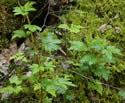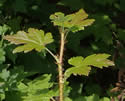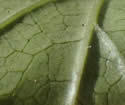Ribes lacustre (Swamp Black Currant)
| Also known as: | Bristly Swamp Currant, Bristly Black Currant, Prickly Currant, Black Swamp Gooseberry |
|---|---|
| Genus: | Ribes |
| Family: | Grossulariaceae (Gooseberry) |
| Life cycle: | perennial woody |
| Origin: | native |
| Habitat: | part shade; average to moist rocky or peaty soil; swamps, forested talus slopes, cliff ledges, rocky shores |
| Bloom season: | May - July |
| Plant height: | 2 to 5 feet |
| Wetland Indicator Status: | none |
| MN county distribution (click map to enlarge): |  |
| National distribution (click map to enlarge): |  |
Pick an image for a larger view. See the glossary for icon descriptions.
Detailed Information
Flower: 

![[photo of flowers]](/udata/r9ndp23q/trees/ribes-lacustre_0716_131159-t.jpg) Arching to dangling clusters of 4 to 18 stalked flowers arising from leaf axils. Flowers are less than ¼ inch (to 5 mm) across, saucer-shaped with 5 short, spreading, creamy to pinkish petals. The calyx cupping the flower has 5 sepal lobes that are like the petals but larger and showier than the actual petals and are commonly rolled or folded under.
Arching to dangling clusters of 4 to 18 stalked flowers arising from leaf axils. Flowers are less than ¼ inch (to 5 mm) across, saucer-shaped with 5 short, spreading, creamy to pinkish petals. The calyx cupping the flower has 5 sepal lobes that are like the petals but larger and showier than the actual petals and are commonly rolled or folded under.
![[close-up of calyx]](/udata/r9ndp23q/trees/ribes-lacustre_0716_131229-t.jpg) Between the calyx and flower stalk is a green ovary covered in red hairs that are tipped with a dark gland. At the base of the flower stalk is a leaf-like bract sparsely covered in glandular hairs. Flower stalks are up to 3/8 inch (to 1 cm) long, covered in a mix of glandular and non-glandular hairs, and have a joint just below the ovary that may appear as a darker line.
Between the calyx and flower stalk is a green ovary covered in red hairs that are tipped with a dark gland. At the base of the flower stalk is a leaf-like bract sparsely covered in glandular hairs. Flower stalks are up to 3/8 inch (to 1 cm) long, covered in a mix of glandular and non-glandular hairs, and have a joint just below the ovary that may appear as a darker line.
Leaves and stems: 


![[photo of leaves]](/udata/r9ndp23q/trees/ribes-lacustre_0711_122449-t.jpg) Leaves are ¾ to 2¾ inches (2 to 7 cm) long, about as wide, coarsely toothed with rounded teeth, straight to heart-shaped at the base, with 3 to 5 primary lobes that may be again shallowly lobed, the primary lobes cleft half or more to the midvein and more or less pointed at the tip. Surfaces are hairless to sparsely covered in glandular hairs that may be mixed with non-glandular hairs. Leaf stalks are up to 2 inches (to 5.5 cm) long, covered in a mix of glandular and non-glandular hairs of varying lengths.
Leaves are ¾ to 2¾ inches (2 to 7 cm) long, about as wide, coarsely toothed with rounded teeth, straight to heart-shaped at the base, with 3 to 5 primary lobes that may be again shallowly lobed, the primary lobes cleft half or more to the midvein and more or less pointed at the tip. Surfaces are hairless to sparsely covered in glandular hairs that may be mixed with non-glandular hairs. Leaf stalks are up to 2 inches (to 5.5 cm) long, covered in a mix of glandular and non-glandular hairs of varying lengths.
![[photo of prickly stem]](/udata/r9ndp23q/trees/ribes-lacustre_0711_122631-t.jpg) New twigs are green and minutely hairy, becoming smooth when the thin outer layer peels away. Older stems are brown to reddish and densely covered in reddish to orange prickles of varying lengths that eventually turn brown like the bark. At leaf and branch nodes are usually 1 to 3 larger spines, but these can be obscured by the prickles. Stems are single or few from the base, erect to prostrate, not rooting at the nodes.
New twigs are green and minutely hairy, becoming smooth when the thin outer layer peels away. Older stems are brown to reddish and densely covered in reddish to orange prickles of varying lengths that eventually turn brown like the bark. At leaf and branch nodes are usually 1 to 3 larger spines, but these can be obscured by the prickles. Stems are single or few from the base, erect to prostrate, not rooting at the nodes.
Fruit: 
![[photo of developing fruit]](/udata/r9ndp23q/trees/ribes-lacustre_0711_122141-t.jpg) Fruit is a round berry ¼ to 3/8 inch (5 to 10 mm) in diameter, covered in red gland-tipped hairs and ripening from green to purple-black. Mature fruit drops off from the joint on the flower stalk, leaving the lower part of the stalk behind on the stem.
Fruit is a round berry ¼ to 3/8 inch (5 to 10 mm) in diameter, covered in red gland-tipped hairs and ripening from green to purple-black. Mature fruit drops off from the joint on the flower stalk, leaving the lower part of the stalk behind on the stem.
Notes:
The Ribes species consist of both gooseberries and currants. Usually, currants are distinguished by their lack of any spines, prickles or thorns on the stems, which all gooseberries have to some degree, and clusters of 6 or more flowers, where gooseberries have clusters of only 1 to 4 flowers. Ribes lacustre is the exception, having a very prickly stem and clusters of more than 4 flowers, which may be why it's been commonly called both a currant and a gooseberry.
When flowers or fruits are present it is easily distinguished by the very prickly stem combined with glandular-hairy flowers and fruits. Other Currants that may have similarly shaped flowers and/or glandular-hairy fruits lack the prickly stem. Prickly Gooseberry (R. cynosbati) and Northern Gooseberry (R. oxyacanthoides) both may have a similarly prickly stem but have fewer flowers per cluster, lack the gland-tipped hairs on fruits and leaves are hairier.
Native Plant Nurseries, Restoration and Landscaping Services ↓
More photos
 Swamp Black Currant plant
Swamp Black Currant plant Swamp Black Currant plant
Swamp Black Currant plant Swamp Black Currant habitat
Swamp Black Currant habitat flowering plant
flowering plant leaf stalks have a mix of variable-length glandular and non-glandular hairs
leaf stalks have a mix of variable-length glandular and non-glandular hairs leaf surfaces are hairless to sparsely hairy
leaf surfaces are hairless to sparsely hairy
Photos by K. Chayka taken in Cook County.
Comments
Have you seen this plant in Minnesota, or have any other comments about it?






